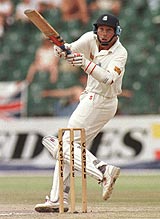First of all, rather surprisingly Anil Kumble didn't do this. In the match
at Delhi in 1998-99 when he took all ten wickets in the second innings, Waqar Younis escaped his clutches - and he was not out in the first innings too. Jim Laker did do it though,
at Old Trafford in 1956 - Australia's captain Ian Johnson remained not out when Laker took all ten, but had fallen to him in the first innings. Five other people have achieved this feat: the next one after Laker was another offspinner, India's Srinivas Venkataraghavan, against New Zealand
at Delhi in 1964-65. He dismissed all 11 batsmen but only claimed 12 wickets in the match - Terry Jarvis was the only man he nabbed twice. And Venkat was on the receiving end the next time it happened, by Australia's Geoff Dymock
at Kanpur in 1979-80 - his 12 wickets included Shivlal Yadav twice (but Venkat and the others only once). Abdul Qadir did it for Pakistan against England
at Lahore in 1987-88: he took nine wickets in the first innings, and four in the second, including David Capel and Bruce French, who had eluded him first time round. Next was Waqar Younis - the man who denied Kumble - for Pakistan against New Zealand
at Faisalabad in 1990-91. Again he "only" took 12 wickets, with Willie Watson the double victim. The most recent occurrence came
at Galle in July 2000, when Muttiah Muralitharan's 13 wickets included all 11 South Africans.
